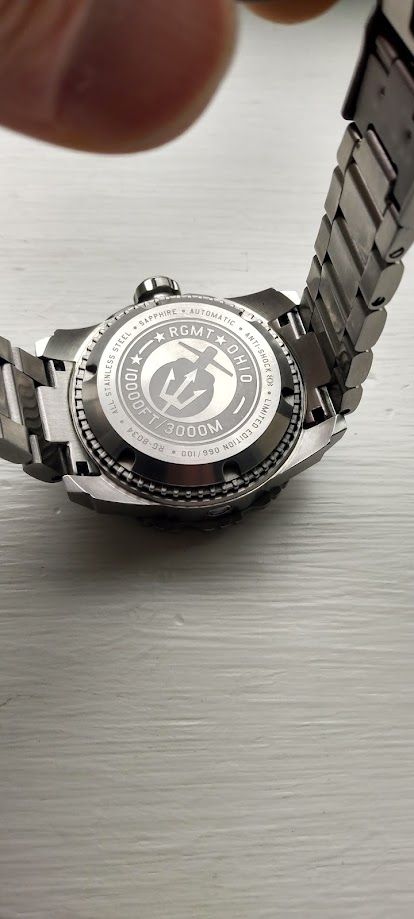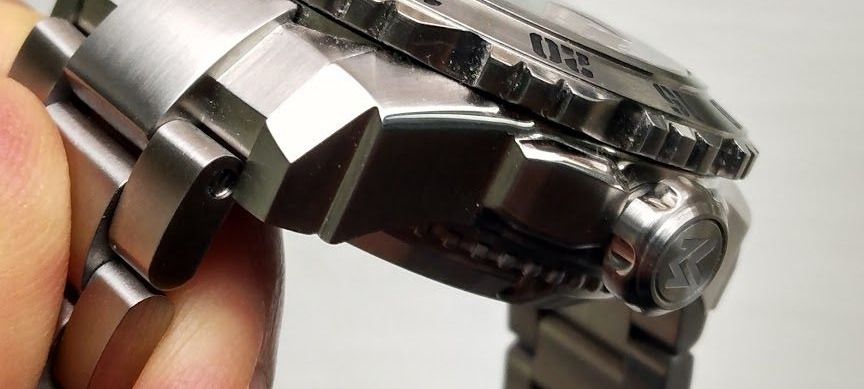Model #s:
Polaris: FDJ05003W0
Neptune:
RA-EL0001B00A
Brand/Model: Orient Polaris & Orient Neptune
Movements: In-House Japanese
automatic
Materials: Polaris: stainless steel case with leather strap; Neptune: stainless steel case with
stainless steel bracelet
Complications: Both watches have date displays and power
reserve meters, Polaris also has an independently adjustable GMT hand
Price: Polaris:
$575 USD; Neptune: $685 USD (both
can be found much lower online or in the secondhand market)
Plenty of photos follow the review.
Click on the pictures to enlarge. Please
note the Neptune diver is shown on an aftermarket leather strap in place of the
factory stainless steel bracelet
I’ve always had a
soft spot for Orient brand watches. The
company is now 100-percent owned by Seiko, but still produces a wide range of
watches that are distinctly Orient without any Seiko influence, as it should
be. Orient watches deliver quality and
great value at affordable price points, many times discounted even further
online.
For this review, I
wanted to cover two Orient watches I recently acquired, and while different in
their appearance, still share many of the same characteristics and Orient
fundamentals. I thought it would be fun
to compare and contrast these two models, the Polaris and the Neptune.
I still don’t know
where all these names for various watch models come from and it’s really gotten
to the point of being ridiculous, even Rolex watches have monikers now
(although not officially from the company).
What makes this Orient GMT a ‘Polaris’?
Same goes for the diver, what constitutes it as a ‘Neptune’? Regardless of the naming scheme, these two
watches are fine examples of what Orient brings to the table and would be
worthy additions to any watch collection.
To clarify from the
start, the Orient Polaris is more or less a dressy watch, with a light silver
or white textured dial, blued hands and a GMT complication. The Orient Neptune is a purpose-built diver
(tool watch) with strong lume, higher water resistance and a rotating
bezel. Let’s start the comparison.
Here are the items that are the same with the Orient
Polaris and the Orient Neptune:
-Movements: in-house Japan-made automatics; Neptune caliber 40N5A; Polaris caliber 40P51
-Case material:
stainless steel
-Casebacks: screwdown stainless steel (display back on
the Polaris)
-Crystals: sapphire
-Complications: quick set dates and power reserve meters,
Polaris adds an independently adjustable GMT hand
-Lug width: 22mm on both watches
-Presentation: modest black inner and outer boxes
And the differences:
-Case dimensions: Neptune measures 43.4mm, Thickness 14.1mm;
Polaris measures 42mm, Thickness 12.1mm
-Bezel insert material: Neptune has black aluminum insert with a
rotating bezel, Polaris has polished stainless steel bezel as part of the case
-Lume: Neptune has great green lume, Polaris has no
lume
-Dial color and
markers: Neptune dial is black with
applied markers; Polaris has a white/silver dial with texturing and silver
applied markers
-Hand set: Neptune has silver tone sword style hands with
inset lume; Polaris has blue tone Dauphine style hands with no lume
-Bracelet: Neptune has stainless steel bracelet with
double locking clasp and stamped steel deployant; Polaris has leather strap
with polished machined deployant
The Polaris caught
my eye because of its GMT complication coupled with a power reserve meter,
which are two complications I really like and are not seen too often together
on a watch. The Polaris has a fully
polished stainless steel case that measures 42mm without the unsigned,
non-screwdown crown; 44.5mm crown inclusive.
Thickness is 12.1mm, lug width is 22mm.
The stainless steel
screwdown caseback is a display type with a mineral crystal that shows off the
mildly decorated 22-jewel movement that also features a nicely signed rotor. The top crystal is sapphire.
The Polaris
features an alligator-grain brown leather strap and polished pushbutton machined
deployant. The strap measures 22mm at
the lugs and tapers to 19.6mm at the clasp.
As you can see from the pictures, the clasp is a bit cumbersome and not
all that comfortable, so I may be installing a different strap with a standard
pin buckle instead of the deployant.
The Polaris dial is
a light silver or white with a textured inner circle. The faceted markers are polished silver tone
and are applied, giving them a rich, classy appearance. All the hands are blue-toned with no
lume. The hour and minute hands are
Dauphine style, while the center seconds hand is a simple blue stick.
The GMT hand is a
stick with an open pointer on its end.
The 24-hour GMT track encircles the perimeter of the dial, acting as the
chapter ring. The GMT hand is
independently adjustable, allowing you to track a second time zone with
ease. The hand is set by pulling the
crown out to the first click position, and rotating the crown
counter-clockwise. Rotating the crown
clockwise in this position sets the date.
This procedure is opposite of the GMT hand setting on the popular ETA
2893-2 movement, which sets the GMT hand in the clockwise position and the date
in the counter-clockwise position.
A quickset date resides
at the three position framed with a silver square. The date wheel is black on white and
alignment within the window is good. The
power reserve meter sits below the 12 position on the dial and is graduated in
10-hour increments from zero to 40.
An Orient logo and
script with the word ‘automatic’ reside at the nine position on the dial, while
another logo, ‘water resist’ and ‘GMT’ are present above the six position.
The Polaris is
factory rated at 50 meters of water resistance.
Overall, the dial
is a clean, clear and fairly open layout that is easy to read and even though
there’s no lume, the blued hands really look sharp.
Fit and finish is
what I expect from Orient, which is excellent, especially for the price point.
The watch
winds, hacks, sets and aligns as it should, the quickset date, power reserve
meter and GMT hand work fine and it turned in a good 45 and two-thirds hour
power reserve.
If you’re looking
for a fairly dressy GMT watch that you won’t see everyday, you certainly can’t
go wrong with the Orient Polaris.
And now onto the
Orient Neptune!
When it comes to
divers, Orient has you covered and the Orient Neptune is no exception. Building on the success of the now
discontinued Orient OS300/Pro Saturation Diver of which I have owned two
examples, the Triton is a somewhat smaller version of the Pro Saturation with
slightly less water resistance, but still a rugged, solid watch for a great
price.
After selling my
second OS 300, I was interested in the Neptune due to its smaller dimensions and
lower price and after waiting for the right deal to come along, I pulled the
trigger and got a black dial/black bezel Neptune. The Neptune can also be had in blue with a
blue bezel and black with two tone accents on the bezel and hands.
The Neptune has a
polished and brushed stainless steel case that measures 43.4mm without the
signed screw down crown that’s located at the 4 position. The crown also features a black stripe in the
center, which makes it easier to identify whether the crown is screwed down or
not. The crown action is good with about
2-1/2 turns to lock it down.
The Neptune measures
47.2mm with its crown. Thickness is
14.1mm and lug width is 22mm, with the lugs being drilled for easier strap
changes.
Speaking of which,
the photos show the aftermarket 22mm strap I installed instead of the factory
stainless steel bracelet, which features solid links, solid end links, a
pushbutton double locking clasp and a stamped steel deployant. The bracelet is brushed on top with the sides
of the links being polished. The
bracelet measures 22mm at the lugs and tapers to 19.9mm at the clasp.
The caseback is
stainless steel, screwdown and is nicely embossed with the Orient logo in the
center. The crystal is sapphire.
The Neptune is
factory rated at a fine 200 meters of water resistance and complies with the Japanese Industrial Standard (JIS) for a
Class 1 Diver watch. This classification
makes it usable for recreational scuba diving.
The Neptune features
a 120-click uni-directional rotating bezel with a black aluminum insert
and a lume pip at 12. The bezel is graduated in one minute
increments, with hash marks throughout and arabics every ten minutes (10, 20,
30, etc.) Bezel action is fairly good
with some backlash.
The Neptune dial is
black with a quickset date angled at the four position. The date wheel is white on black; alignment
within the window is good. The power
reserve meter is located between the 12 and 2 positions and is graduated the
same as the Polaris meter, although the zero to 10 hour part of the meter is
red, with the rest of the meter being black.
The power reserve pointer is red.
All the markers on
the dial are applied with inset lume, with rectangular markers at 3, 6 and 9,
with an inverse triangle marker at 12.
The remainder of the markers are round (and not too large, thank you
Orient, as too many dive watches these days have oversized round markers that
make the watch look clownish).
The hands are
silver tone with inset lume, the hour hand is a pointer style with the minute
hand being a sword style. The seconds
hand is a pointer style with a long tip at the end.
Lume is green and
strong, as Orient lume usually is.
Above the six
position are the Orient logo and script, along with ‘automatic’ and ‘Diver’s
200m’. Overall, the dial is easy to read
and very purposeful.
Functionally, the Neptune is great. The 40N5A 22 jewel
automatic movement is the same movement that was featured in the Pro Saturation
diver. Beating at 21,600 vph, the Neptune turned in an average accuracy of -11 seconds over 24 hours during my
testing. Power reserve was an ample 46.5
hours. The watch winds, sets and hacks as
it should, with the quickset date and power reserve functions working fine.
The Neptune is one
of the best values going in a true dive watch these days and is a very
affordable watch, especially when purchased second hand.
Overall, while
different in their appearance and functions, but not different in their
approach, the Orient Polaris and Orient Neptune are two fine watches that have
good in-house movements, good overall performance and a price/value equation
that’s hard to top. Now you can see why
I like Orient watches and what they have to offer.
Pros-
Polaris: clean dial, independently adjustable GMT
hand, power reserve meter, good price point
Neptune: solid
build, good lume, power reserve meter, nicely sized for a true diver
Cons-
Polaris: blue hands a bit too blue, no lume, clasp is somewhat cumbersome
Neptune:
accuracy could be better, bezel action could be tighter
Verdict: both
of these Orients deliver the goods, with overall quality, features and looks
that are hard to beat, especially at the price.
Orient does it again!
Thanks for reading
and enjoy the pics.
Excelsior!
-Marc



































































